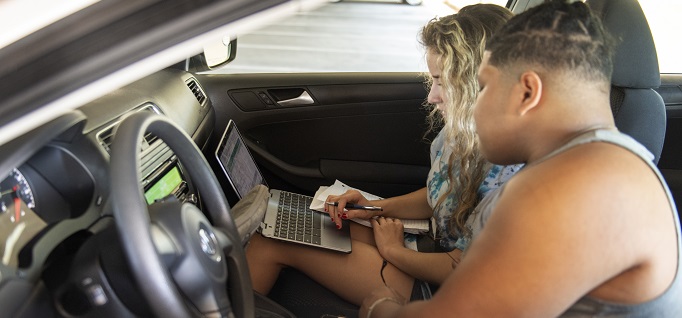High-tech, high-touch
By Douglas J. Guth
July 30, 2020
How a Texas college has kept students connected during the pandemic.
With nine sites serving 60,000 students, Collin College in Texas transitioned 3,100 classes online March 20, launching the new programming a week later. The campus closure exacerbated a “digital divide” where some learners were less likely than others to have consistent access to reliable technology.
In response, Collin College opened a designated drive-in Wi-Fi space, where students swipe an ID card and take virtual classes in a covered parking garage.
“There’s Wi-Fi antennas in the garage for high-speed access,” Chief Innovation Officer Michael Dickson says. “It’s not perfect, but students don’t have to sit in the hot sun.”
A pre-pandemic online learning push, driven by administrators including President Neil Matkin, already offered 900 remote classes as well as an Electronic Learning Center, or ELC, that provides labs, academic advising and other 24/7 resources.
“We adopted Canvas a couple of years back and require faculty to post syllabi and class materials on the platform,” Dickson says. “We had a head start on a lot of this, so that paved the way for making the transition.”
As for increased remote testing demands, the college is using the HonorLock online proctor service after starting a pilot in January. Faculty members also are familiar with tools that allow for hands-on engagement and visualization of various lab exercises. Tech specialists who normally patrolled the classroom are now staffing a student information desk, offering callers assistance on any technological need.
“A high-tech, high-touch approach has made a huge difference for enrollment,” says Dickson. “I expected enrollment to crater, but the percentage of drops is consistent with what we have every semester. If we didn’t have these aggressive measures, I shudder to think what it would’ve taken to move that amount of classes in so short a time.”
Dickson lauds president Matkin for laying the groundwork for the pandemic-generated changeover, an effort fueled by a patient staff who underwent one-on-one training from IT on tools with which they were unfamiliar.
Outside the occasional “Zoombombing”—a type of cyberattack where someone hijacks a Zoom teleconferencing chat—security hasn’t been an issue in the college’s brave new academic world. Combining heightened training and mentoring with enhanced security protocols has kept both students and instructors safe. Dickson is proud of the tech services department whose role has expanded since March, not to mention faculty that have remained agile even as teaching protocols developed.
“You can fall into a pattern when in higher education for so long,” says Dickson. “But the old rules are over, and now we’re exploring some new ones. Faculty found that extremely liberating, even those who never thought they’d teach online. It’s a challenge, but we couldn’t have done this without the enthusiasm of our faculty.”
This is just a snippet from a longer article that you can read in the upcoming August/September issue of Community College Journal.



